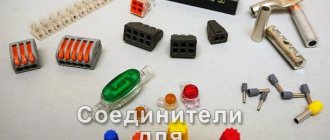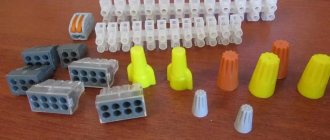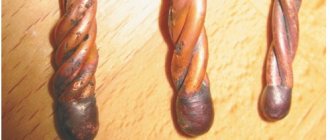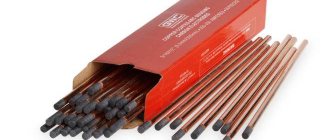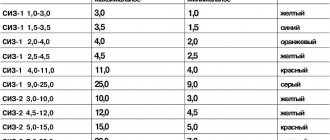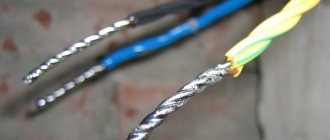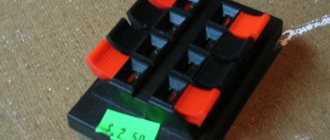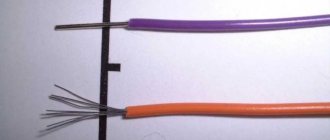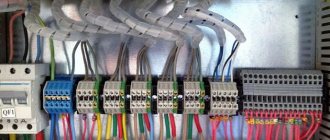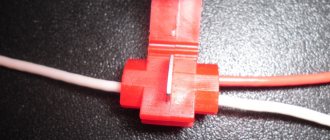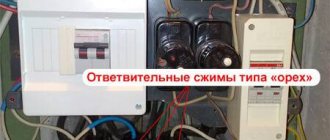What is the best way to connect the wires?
The debate about which wire connection is better continues even among experienced electricians?
To resolve this issue, an objective approach is needed. If we talk about twisting, it has a history from the founding of electrification; this honorable “old man” deserves our great respect! But what was supposed to happen happened, the development of modern technologies is taking over in this field too, meaning the invention of Wago terminal connections, which stepped on the “heels” of twisting and twisting lovers really don’t like it. Vagolyubov can also be reproached for taking an extreme position, since such a connection of wires (Vago terminals) has its drawbacks. which is better to choose a terminal block or twist
A balanced approach to connecting conductors may convince you that these two connections have a right to exist. It is worth noting that the PUE does not welcome twisting, that is, such a scheme - the wires are twisted and insulated, but at the same time, it does not object to soldering and welding twists.
PUE: clause 2.1.21. Connection, branching and terminating of wires and cables must be carried out using crimping, welding, soldering or clamping (screw, bolt, etc.) in accordance with current instructions.
Objects subject to fire inspection are strictly monitored for the presence of wire connections and any twisting is quickly stopped. In other words, most fires occur due to poor-quality connections, in other words, they twist everything that comes to hand, namely: twists consisting of copper and aluminum, soft wire with hard wire, etc. As a result, the twists are poorly compressed, which causes big troubles.
twist
Wago terminals exclude such provocations, but at the same time they are not a panacea and an absolute guarantee of impeccable protection. Wago terminals are designed to withstand a load of 3.5 to 5 kW, depending on the series, therefore, they cannot be installed everywhere. If the terminal melts, it means that, in general, there is an overload on the wiring and the problem lies in a not entirely correctly selected circuit breaker, which should protect against such negative manifestations. Terminal melting problem mainly occurs in old houses where there is no proper control over the wiring and conductor connections.
connecting wires using wago terminals
In modern new buildings, Wago terminals are mainly used and there are no complaints from residents. The fact is that for such consumers as: a boiler, a washing machine, a dishwasher, separate power lines are laid without any connections, and for lighting and socket groups, terminals are used that are not subject to large network overloads.
In other new buildings, twisting is used without soldering and welding, but using PPE terminals, which have proven to be quite reliable terminals. The only drawback of PPE terminals is the large labor costs, in contrast to Wago terminals, which easily and quickly connect wires, and this gives a huge advantage on large objects, where speed and time dictate their own rules.
PPE terminals
Be sure to read detailed articles about connecting wires :
- "Modern methods of connecting wires"
- “Connection of wires in a junction box? SCHEME"
- “PPE caps for twisting wires. Electrician's Tips"
Construction and installation clamps
The most popular are Wago flat spring terminal clamps. They consist of a terminal block, a pressure spring and keys. The cores are inserted into the block and pressed using keys. The insulation is made of polyamide.
Advantages of flat spring clamps:
- Connection of several cores . You can connect several cores at the same time, which is very convenient when creating wiring in a junction box.
- Connection of conductors from different metals . Using Wago you can connect aluminum and copper conductors. Thanks to this, such terminal clamps are suitable for wiring in old houses where aluminum wiring is still used.
- Fixation of single-wire and multi-wire conductors . You can combine connections of cores of different designs.
- Connection speed . Installing a clamp takes less time than when organizing twisting or installing a screw terminal block.
- Small sizes. Due to their small dimensions, the terminal blocks fit comfortably into the box.
- Connector for indicator screwdriver. Using the hole, you can check the presence of voltage in the wire (or find the phase). A striking example of such a screwdriver is STANLEY 220-250 V
Disadvantages of flat spring clamps:
- High price . On average, one clamp costs from 15 to 50 rubles, depending on the modification and cross-section of the wire for which it is intended. This is approximately 25 times more expensive than PPE and 10 times more expensive than screw terminal blocks.
- Low quality analogues . Wago and Weidmüller are high quality German clamps. However, there are many Russian and Chinese analogues (counterfeits) on the market, the insulation of which can withstand less load and is susceptible to burning. For this reason, there is a risk of getting a bad contact on the line.
Wago flat spring clamps are suitable for both lighting and all wiring in the house. They are reliable and durable. Some of the models are reusable.
Another type of construction and installation clamps are KBM. The principle of their operation is similar to Wago, with the only difference in design. They are also cheaper than their German counterparts, which makes them very popular among domestic electricians. KBMs do not require additional equipment for installation and provide good “clean” contact.
Types of wire connections
The first type is self-clamping terminal blocks. Let's look at this type of connection in more detail. Quite often, when installing electrical wiring, it is necessary to connect aluminum and copper wires with different cross-sections, stiffness and number of cores. But safety precautions strictly prohibit making twists from aluminum and copper materials. Until recently, connections using screws were considered the most reliable, until more convenient Wago spring terminals appeared.
Today, two types of spring connections of this brand are most widespread:
- universal, equipped with a tension spring;
universal clamp
- specialized flat-spring terminals.
flat spring clamp
The first type is designed for stranded (soft) wires, and the second type is designed only for solid (hard) wires.
Advantages of Wago connection terminals
advantage of spring terminal connections
Wago spring terminals have many advantages, including:
- The quality of the contact of this terminal does not depend on the qualifications of the technician who performed the wiring.
- The ability to connect quite quickly without using a specialized tool.
- Excellent protection against accidental contact with current-carrying surfaces.
- Highest contact reliability.
- Possibility to make changes to the wiring without breaking the connection.
- Availability of a separate socket for each wire.
- High vibration and impact resistance.
- Automatic control of the clamping force on the wire.
- No need for care or special maintenance.
- The electrical conductors in these terminals have excellent resistance to damage.
- The terminals have a Rostest certificate and permission from Gosenergonadzor.
- Excellent quality/price ratio.
wire clamp
During the installation process, the insulated wire is inserted into the flat-spring drive all the way into the corresponding hole, and at this moment optimal pressure appears on the contact, which does not depend on the cross-sectional area of the conductor. The flat-spring mechanism perfectly presses the wire core to the busbar, which completely eliminates its spontaneous disconnection. To carry out the necessary measurements, there is a special hole in the terminal body that will provide access and visual contact to the electrical bus. When the terminal is connected correctly, the possibility of touching live elements and causing a short circuit is completely eliminated.
reliable wire clamp
If the need arises, you can disassemble the electrical connection; simply pull out the wire with a slight movement, turning it slightly. To remove the flexible conductor, you need to lightly squeeze the terminal, then pull the wire. WAGO terminals allow you to quickly reconnect an electrical circuit without additional stripping of the insulation.
Safety Tips and Rules
Only craftsmen with a qualification group are allowed to weld. Persons who have skills in working with a soldering iron are also allowed to solder.
Cables may only be connected in the manner permitted for them. Do not work with damaged wiring. All exposed parts must be insulated.
You can connect the cables in different ways. The choice of connection method is determined by the material, cross-section diameter and other parameters. For electrical equipment to operate correctly, the conductors need to be connected securely. In case of unreliable contact, there is a risk of fire.
The need to fasten wires together can arise for many reasons, and if you are interested in the question: “How to connect wires correctly?”, We advise you to read the materials in this article. To carry out this type of work, you need to understand what the order and features of connecting the wires are, and carefully study what methods can be used to connect them. Let's try to tell you in as much detail as possible about the main ways to solve this problem, consider the process of fastening the cables step by step, and show a photo of how to properly connect the wires on your own.
Some types of Wago terminals
Today, the following types of Wago terminals are most common on the domestic market:
- 1. 773 series is specially designed for use in distribution boxes. Using these terminals you can connect from two to eight wires with a cross-section from 0.75 to 2.5 square meters. mm. They are designed to operate at 400 V. These terminals use a spring-loaded clamp to connect rigid, single-core electrical wires. Most often they use wires with a cross-section of 2.5 and 1.5 square meters. mm.
wago series 773
- 2. Series 273 is also designed for use in junction boxes. These terminals are designed to connect three wires with a cross-section from 1.5 to 4 square meters. mm. They are designed to operate at 400 V. The terminals are complementary to the 773 series, and are typically used to connect wires larger than 2.5 kV. mm.
wago series 273
- 3. 224 series is designed for various lighting applications. These terminals are used to connect two or three wires with a cross-section from 0.5 to 2.5 square meters. mm. They are designed to operate at a voltage of 400 V. These terminals use two types of clamps. Universal clamps are installed on the luminaire side for connecting stranded and fine-core wires, and on the mounting side there are flat-spring clamps for single-core rigid wires. Terminals from this series are specifically designed for lighting, but can be used when installing various devices with flexible wires.
wago series 224
Dosage
Derinat is used internally and externally, the solution is dripped into the eyes, nose, rinsed with it in the mouth, and made compresses. It can be used for patients of any age category.
Rinsing is done for diseases of the oral cavity (one bottle is enough for 2 procedures). Take the drug 5 times in 24 hours. The duration of treatment is from 7 to 10 days.
For chronic genital infections, the solution is administered intravaginally, the cervix is irrigated or a tampon soaked in liquid is inserted. Use 5 ml of solution for 1 procedure, repeat twice for 2 weeks.
Use the solution to irrigate the rectum in the following dosage - from 16 to 40 ml of liquid per time. The therapeutic course lasts from 5 to 10 days. Administer the drug by enema.
To restore the skin or mucous membranes, a bandage moistened with a solution is applied to the damaged areas, repeat frequency is three times. Indications for application: necrosis of the skin or internal membranes, slowly healing wounds, trophic ulcers. The list of indications can be supplemented with thermal damage and gangrene.
As the instructions say, Derinat is used to prevent ARVI in the following dosage - 2 drops in each nostril two or three times. Treatment in this case lasts from 7 to 14 days.
Use the solution for colds in the following dosage - 2 to 3 drops in each nostril at intervals of 60–90 minutes. When the cold symptoms disappear, follow the dosage – 2 drops three times for 30 days.
Use drops for rhinitis and sinusitis in the following dosage: from 3 to 5 drops in each nostril four or five times. The therapeutic course for a runny nose is 7–14 days.
As the instructions say, the solution is administered intramuscularly for ischemia, peptic ulcers, tuberculosis, and acute inflammation. The dosage is determined by the doctor for each patient individually.
Materials used in the manufacture of Wago terminals
In the manufacture of Wago terminals, polyamide is usually used as a material that insulates live parts. It is a poorly flammable, corrosion-neutral material that has self-extinguishing properties. The upper limit of the short-term temperature of polyamide is more than 170 degrees Celsius, and the lower limit is less than - 35 degrees Celsius. Current-carrying elements are made of special electrolytic copper and have a tin-lead coating, which guarantees long-term corrosion protection. When exposed to high specific pressure at the contact point in the clamp, the surface of the conductor is laid in a special lead-tin layer in the contact zone. This guarantees high reliability of protection of the contact point from various corrosive influences.
wago terminal material
The clamps in the spring terminals are made of high quality chromium-nickel steels, which have excellent tensile strength. During the entire period of operation of such materials, not a single case of contact corrosion was detected between the contact materials and the chrome-nickel steel of the spring, which allows the use of Wago terminals even for connecting copper wires.
chromium-nickel steel plates vago reliable spring clamp conductor
Wago construction terminals make it possible, after connecting single-core and stranded wires, if the need arises, to easily change the configuration without using a special tool. Today, Wago terminals are used in construction almost all over the world. The reason for their high popularity lies in their high reliability and ease of installation.
Screw terminal block
A screw terminal block is a metal tubular connector with screws, encased in a plastic housing. Two wires are inserted into the terminal block and tightly clamped with screws.
Advantages of a screw terminal block:
- Excellent contact . Thanks to the high clamping force of the screw, good contact is created in the connection, which leads to lower resistance and, as a result, better electrical conductivity.
- Availability of insulation . The current-carrying part is covered in plastic insulation, so no additional insulation is required.
- Inexpensive. Compared to self-clamping terminal blocks, screw terminal blocks are an order of magnitude cheaper, so with a large volume of connections, for example, to lighting groups, they will allow you to save a lot of money.
Disadvantages of screw terminal blocks:
- Need for maintenance . At least once a year it is necessary to tighten the bolts to ensure reliable contact. This factor does not make it possible to tightly sew terminal blocks under drywall or plaster.
- Difficulty in using stranded wires . Their use is only possible with additional crimping with brass tips.
Screw terminal blocks are mostly suitable for electrical control rooms, where there is always access for repairs and inspections.
The self-insulating clamp is a regular plastic cap with a spring inside. It is enough to place two wires there and twist them with a cap. You can call it one of the types of twisting, but with existing insulation.
Pros of PPE:
- Cheap connection . Caps are cheaper than other connectors, so if you have a large number of twists, you can save a lot of money. On average, a pack of 50 caps can be purchased for 90 - 100 rubles.
- Easy installation . Their installation does not require special skills or a lot of time - they are installed in literally 1 minute.
- Non-flammable material . The cap material does not burn, so the possibility of spontaneous combustion of the connector is eliminated.
- A large number of colors. This allows different colors to separate the phases and the grounding conductor.
Twisting of conductors
Due to the relocation of the electric stove in the kitchen, it is not always possible to lay a new power cable, so you have to extend the old one. Some plates can consume up to 7 kW of electricity, and here ordinary twisting is not enough, and soldering or welding conductors is labor-intensive. In this case, it is better to use a terminal block designed for a rated current of 60A to connect the conductors.
